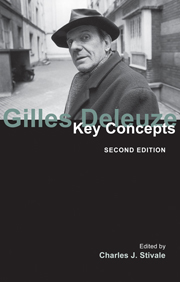Book contents
- Frontmatter
- Contents
- Contributors
- Acknowledgements
- Abbreviations
- Introduction: Gilles Deleuze, a life in friendship
- PART I PHILOSOPHIES
- PART II ENCOUNTERS
- 5 Sense, series
- 6 Event
- 7 Assemblage
- 8 Micropolitics
- 9 Becoming-woman
- 10 The minor
- 11 Style, stutter
- 12 The logic of sensation
- 13 Cinema
- Part III FOLDS
- Chronology
- Bibliography
- Index
13 - Cinema
from PART II - ENCOUNTERS
- Frontmatter
- Contents
- Contributors
- Acknowledgements
- Abbreviations
- Introduction: Gilles Deleuze, a life in friendship
- PART I PHILOSOPHIES
- PART II ENCOUNTERS
- 5 Sense, series
- 6 Event
- 7 Assemblage
- 8 Micropolitics
- 9 Becoming-woman
- 10 The minor
- 11 Style, stutter
- 12 The logic of sensation
- 13 Cinema
- Part III FOLDS
- Chronology
- Bibliography
- Index
Summary
Is that everything? It seemed like he said quite a bit more than that.
Bob (Bill Murray) to translator,
Lost in Translation
(dir. S. Coppola 2003)The criteria for working with Deleuze's cinema books – Cinema 1: The Movement-Image, and Cinema 2: The Time-Image – might be summarized quite simply: how and where do we see, hear and sense the perception of being? What is learnt, what is lost, what is wasted, what is invented in the recognition of the narratives, concepts and structures of life, giving rise to images of meaning in the cinema? How does the activity of relationally generated thought-perception occur within the cinema, and how might it be analysed?
If a viewer selects a favourite colour, character, dialogue, moment, movement, sound or gesture from any film, that aspect, person or thing has its characteristic and/or its gesture given in the juxtaposition between the viewer's contextual perceptual space, aesthetic preferences, historical moment and that aspect, person or thing itself. The conjunction and coordination of this vast range of possibilities provide the pulsing channels of perceptual power (puissance), and becoming perception of and between entities. According to Deleuze, the cinema provides such passageways of thought, showing itself to be a profound and sometimes rigorous surface that covers the visible world.
Deleuze's cinema books engage four fundamental interrelational concepts with which to chart a philosophy of cinema: movement, image, recognition and time.
- Type
- Chapter
- Information
- Gilles DeleuzeKey Concepts, pp. 163 - 178Publisher: Acumen PublishingPrint publication year: 2011



